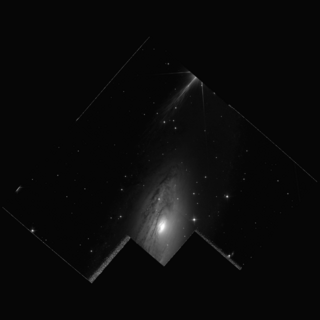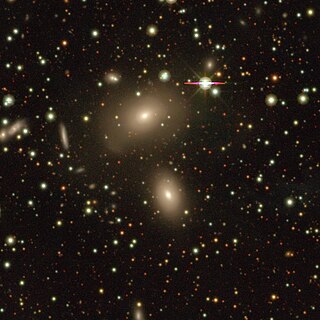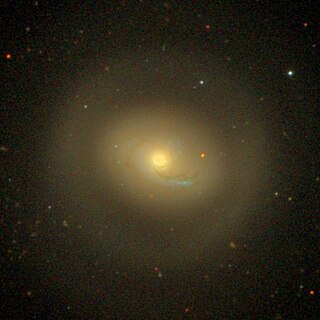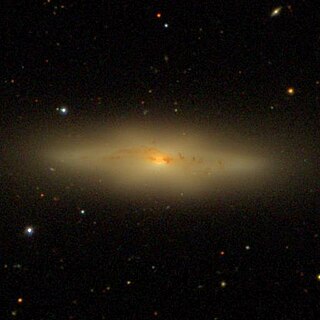
NGC 254 is a lenticular galaxy located in the constellation Sculptor. It was discovered by John Herschel in 1834. It is in a galaxy group with NGC 134.

NGC 7013 is a relatively nearby spiral or lenticular galaxy estimated to be around 37 to 41.4 million light-years away from Earth in the constellation of Cygnus. NGC 7013 was discovered by English astronomer William Herschel on July 17, 1784 and was also observed by his son, astronomer John Herschel on September 15, 1828.

NGC 7020 is a barred lenticular galaxy located about 140 million light-years away in the constellation Pavo. NGC 7020 was discovered by astronomer John Herschel on August 31, 1836.

NGC 7033 is a lenticular galaxy located about 390 million light-years away in the constellation of Pegasus. It is part of a pair of galaxies that contains the nearby galaxy NGC 7034. NGC 7033 was discovered by astronomer Albert Marth on September 17, 1863.

NGC 7041 is a lenticular galaxy located about 80 million light-years away in the constellation of Indus. NGC 7041 was discovered by astronomer John Herschel on July 7, 1834.

NGC 7079 is a barred lenticular galaxy located about 110.58 million light-years away in the constellation of Grus. NGC 7079 is also classified as a LINER galaxy. It is tilted about 51° to the Earth's line of sight. NGC 7079 was discovered by astronomer John Herschel on September 6, 1834.

NGC 4473 is an elliptical galaxy located about 50 million light-years away in the constellation of Coma Berenices. It was discovered by astronomer William Herschel on April 8, 1784. NGC 4473 has an inclination of about 71°. NGC 4473 is a member of a chain of galaxies called Markarian's Chain which is part of the larger Virgo Cluster of galaxies.

NGC 4488 is a lenticular galaxy located about 60 million light-years away in the constellation of Virgo. The galaxy was discovered by astronomer William Herschel on December 28, 1785. NGC 4488 is a member of the Virgo Cluster.

NGC 4457 is an intermediate spiral galaxy located about 55 million light-years away in the constellation of Virgo. It is also classified as a LINER galaxy, a class of active galaxy defined by their spectral line emissions. NGC 4457 Is inclined by about 33°. It was discovered by astronomer William Herschel on February 23, 1784. Despite being listed in the Virgo Cluster Catalog as VCC 1145, NGC 4457 is a member of the Virgo II Groups which form an extension of the Virgo cluster.

NGC 4459 is a lenticular galaxy located about 50 million light-years away in the constellation of Coma Berenices. NGC 4459 is also classified as a LINER galaxy. NGC 4459 was discovered by astronomer William Herschel on January 14, 1787. NGC 4459 is a member of the Virgo Cluster.

NGC 4733 is a barred lenticular galaxy located about 55 million light-years away in the constellation of Virgo. NGC 4733 was discovered by astronomer William Herschel on March 15, 1784. NGC 4733 is a member of the Virgo Cluster.

NGC 4633 is a spiral galaxy located about 70 million light-years away in the constellation of Coma Berenices. It is interacting with the nearby galaxy NGC 4634. NGC 4633 was discovered by astronomer Edward D. Swift on April 27, 1887. It was rediscovered on November 23, 1900, by astronomer Arnold Schwassmann and was later listed as IC 3688. NGC 4633 is a member of the Virgo Cluster.

NGC 4429 is a lenticular galaxy located about 55 million light-years away in the constellation of Virgo. NGC 4429 is tilted at an inclination of about 75° which means that the galaxy is tilted almost edge-on as seen from Earth. NGC 4429 was discovered by astronomer William Herschel on March 15, 1784. The galaxy is a member of the Virgo Cluster.

NGC 4606 is a spiral galaxy located about 55 million light-years away in the constellation of Virgo. NGC 4606 was discovered by astronomer William Herschel on March 15, 1784. It has a disturbed stellar disk suggesting the actions of gravitational interactions. NGC 4607 may be a possible companion of NGC 4606. However, their redshifts differ by about 600 km/s, making it unlikely that they are a gravitationally bound pair. NGC 4606 is a member of the Virgo Cluster.

NGC 4469 is a nearly edge-on spiral galaxy located about 55 million light-years away in the constellation of Virgo. It is also classified as a LINER galaxy. NGC 4469 was discovered by astronomer William Herschel on April 15, 1784. It is a member of the Virgo Cluster.

NGC 4753 is a lenticular galaxy located about 60 million light-years away in the constellation of Virgo. NGC 4753 was discovered by astronomer William Herschel on February 22, 1784. It is notable for having distinct dust lanes that surround its nucleus. It is a member of the NGC 4753 Group of galaxies, which is a member of the Virgo II Groups, a series of galaxies and galaxy clusters strung out from the southern edge of the Virgo Supercluster.

NGC 4476 is a lenticular galaxy located about 55 million light-years away in the constellation Virgo. NGC 4476 was discovered by astronomer William Herschel on April 12, 1784. The galaxy is a member of the Virgo Cluster.

NGC 3859 is a spiral galaxy located about 295 million light-years away in the constellation Leo. It was discovered by astronomer Édouard Stephan on March 23, 1884. The galaxy is a member of the Leo Cluster.

NGC 4302 is an edge-on spiral galaxy located about 55 million light-years away in the constellation Coma Berenices. It was discovered by astronomer William Herschel on April 8, 1784 and is a member of the Virgo Cluster.

NGC 4513 is a lenticular galaxy and a ring galaxy located about 110 million light-years away in the constellation Draco. It was discovered by astronomer Heinrich d'Arrest on October 16, 1866.




















